
Manufactured by: Team Neoflash
Review samples supplied by: IC2005 SmartShop

By The Technologist - 4th January 2014
Review Contents & Index:
- Introduction
- Official Neo SNES Myth Cart Features List
- Packaging and Contents - Cart Design
- Setting Up & Using
- Installation- Hardware
- Installation - Neo2 Ultra Menu and USB Device Drivers
- Installation - Connection to PC
- Transferring ROMs
- Usage - General
- Usage – Super Nintendo Games & Homebrew
- Usage – Super Nintendo Cartridges and Expansions - Neo SNES Myth GUI (Menu)
- Performance:
- ROM Compatibility
- ROM Only + ROM/SRAM
- Bandai Sufami Turbo Games
- C4
- DSP-1
- DSP-2
- DSP-3
- DSP-4
- OBC-1
- SA-1
- S-DD1
- Seta DSP
- SPC 7110 - Homebrew Support
- Additional Features
- Conclusion
It has been almost 4 years since Neo Flash announced their 9th project: the Neo SNES Myth Cart. Many have been long awaiting its arrival and it is finally here.
This is no ordinary type of flash cartridge. It comes in two pieces that need to be combined together with an additional original SNES cartridge when running backup ROM images in the SNES console. The larger piece contains the logic chip, RAM, USB port, SNES cartridge slot, and GBA cartridge slot. A smaller cartridge containing the flash RAM chip is inserted into the GBA cartridge slot for storing and playing games.
There are a few differences between this and SNES backup solutions we have seen come about in the early til mid 1990s. The device is much more compact and almost the size of a typical SNES cartridge. It also does not have a plug for a separate power supply which means that you will need to use it in a deck that supplies enough power to run the cartridge on its own. On the top you will find a USB port to program the device. Most old copiers used a floppy drive and some had a parallel port built in or an external parallel attachment to program their built in RAM. Onboard, you will not find a handful of RAM chips or a microprocessor like in old copiers. There is one memory chip that you load the games to and a programmable logic chip that controls the device's functions as well.
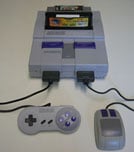
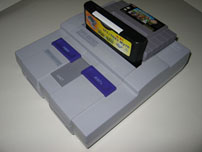
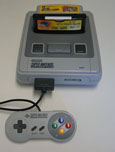
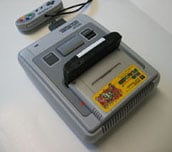
This review will show how to install, configure, and operate the cart as well as go into detail about which ROM images work and how to configure them in the Windows based Neoflash menu software.
Neo SNES Myth Features:
- On Screen SNES Menu System with Multiple ROM Image Support
- Supports Neo2 Flash RAM Cartridges
- Supports Clean, Trained, and Homebrew SNES (Super Nintendo)and SFC (Super Famicom) ROMs
- GBA Slot (For Storing ROMs On Flash RAM and Expandability of Storage)
- Automatically Detect Save Type and ROM Type from Header Information
- Multiple Region Lockout Chip Support
- Supports All (SRAM) Save Types
- Boot Special Chip Games
- Expansion Slot
- USB 2.0 Port
- ON/OFF Switch
The Neo SNES Myth package comes inside a nice re-sealable plastic clam shell (no scissors needed!) and includes the Main Unit with 64Mbit (8 Megabytes) of onboard RAM, 256Mbit (32 Megabytes) Neo2 Myth GBA Flash RAM Cartridge with 16Mbit (2 Megabytes) of menu space, USB 2.0 Cable, Software Installation Mini-CDROM (the sample I received contained no CD-ROM disc), and Cardboard Insert. I tried to turn the unit on without any Flash RAM Cartridge in it and it gave me a black screen. I had the same result if I did not have a SNES cartridge plugged in the expansion slot with or without the Neo2 Flash RAM Cartridge inserted. The Flash RAM Cartridge came with one file on it entitled NEO-SNES-MYTH-DEMO.SMC.
Inside are the following items:
Cart Design
Let's take a closer look at theNeo SNES Myth Cart itself.
The Neo SNES Myth comes in a black housing which has slots from the bottom up to the screw holes so it can be inserted in NTSC SNES decks and is shaped similar to a typical SFC or PAL SNES cart in order to fit inside those consoles as well.
On the top side is a USB 2.0 port and a GBA (Game Boy Advance)cartridge slot for the Neo2 Myth Flash RAM Cartridge.
Behind is the expansion slot where any cartridge containing a lockout chip and possibly a DSP-1 microchip is inserted.
Setting Up & Using
Installation - Hardware
Here is the Neo SNES Myth unit and another view with the 256M Neo2 Flash RAM cart inserted. On the back of the device is a standard SNES cartridge interface where any cartridge containing a lockout chip is inserted. I have found that in order to make it ready to install ROMs, the cartridge interface needs to be empty or else the software will not see it.
It is preferable to just plug in a copy of Super Mario Kart or any cartridge containing a DSP1 chip here (except for Pilotwings)because it will contain both chips necessary to load all games compatible with the Neo SNES Myth cartridge. In the last photos, I am showing how it should look when it is fully assembled and ready to be turned on.
Installation - Neo2 Ultra Menu and USB Drivers
Because this sample was not shipped with the CDROM containing whatever software is necessary to set up the Neo SNES Myth on a PC, I visited the manufacturer's web site at www.neoflash.com. The main page had a link to the latest MD/N64/SNES Myth flashcart PC programmer software which, as of writing this review,was V3.02 [March 5th, 2010]. There was no direct link tothe download, but it is located in the downloads section at http://www.neoflash.com/go/index.php?optio...9&Itemid=30 and takes you to the forum where the download link to the file is. http://www.neoflash.com/myth/NEO2_Ultra_Me...etup_100304.rar
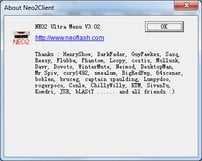
As with many aftermarket Chinese hardware devices, plugging in the USB cable and allowing Windows search for the appropriate driver caused a driver not found error and put it under Unknown Devices in Device Manager. Had I installed the Neo2 Ultra Menu V3.02 before plugging it in, Windows would have automatically found the driver and it would have been ready to go. This is simply all that needs to be done and works without a hitch. Before plugging in the Neo SNES Myth, just run the installation executable from within the downloaded RAR or the installer located on the included CDROM.
After the main program is installed, it will launch the driver installation. Be careful to notice this because when I first installed the software I did not realize that it launched a second installation after it completed. Click through the queries and allow it to install the drivers for the device. During installation, some antivirus software may misleadingly report some DLL files as backdoor trojans. Just tell the antivirus to ignore these warnings and proceed. Once it is finished installing the drivers, the computer will be ready for the device to be plugged in.
Installation - Connection to PC
Make sure there is no cartridge inserted in the back of the device and plug the Neo SNES Myth into one of the PC's USB ports using from the top side of the cartridge's USB port with the A to mini B cable supplied. I did all of my testing using a genuine Canon brand USB 2.0 cable just to be safe because sometimes generic cables tend to be bad from the factory and can cause a lot of issues. Although we are not reviewing USB cables here, I read on their forum that the supplied yellow USB cables were often faulty. This one came with a black one which should be fine. You may use a longer cable than what is supplied and a USB A to A extension with it. I tested this and it does not diminish the signal for data transfer.
Transferring ROMs
Launch the Neo2 Ultra Menu software. It automatically detects what type of Myth cartridge is plugged into the USB port. In this case, it will show SFC/SNES Myth underneath the File and Help menus in a dropdown box (SFC is an abbreviation for the Japanese name of the Super Nintendo which is Super Famicom). The interface software is mainly separated into tabs which each have a different function from advanced configuration, memory management, formatting the card, linking, and adding ROMs to theNeo2 Flash RAM Cartridge.

First we will look at the Advance (or Advanced) tab. This is mainly where you can set up the SD Card directory if you are using a Neo2 SD Cartridge (we won't worry about this because this feature is not yet available and the sample did not come with one). You can also change settings for GBA ROM flashing (in this case, they call it burning) and under Super you can change the skinning of the Neo2 Ultra Menu GUI and change SD Mode and Slim Loader options. These extra settings under Advance and Super should not be changed, but the Skin option can be. I'm leaving all of these on default because the software is still in its early stages anyway.

Next is the Memory tab. Again, most of these items are not going to be used. The N64 U2 section has some tools which since there is no included documentation in the help menu only appear that they partially work. These are for the N64 Myth too, so I should not get too far ahead. Just leave these items alone unless you know what you are doing. In the case of this review, none of these were needed for the games to function.
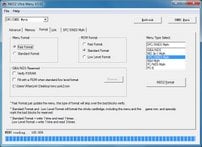
Under the Format tab are options to format the Menu memory on the Neo SNES Myth labeled "Menu Format" as well as the Flash RAM Cartridge's memory which is labeled "ROM Format". Choosing Fast Format under any of these of course will be dramatically faster than Standard Format of the two and Low Level Format of the ROM. Menu Type Select should be SFC/SNES Myth and should not be changed unless you are formatting a Neo2 Flash RAM Cartridge for a different device in the one you are currently using and plan on using it to store the appropriate ROMs for that device. GBA/NDS Reserved should only be used for their respective systems and ROMs. Do note that of course since this is a SNES device, it will not play games for any system besides Super Famicom and SNES and will not work if plugged into anything other than a SNES or Super Famicom console.
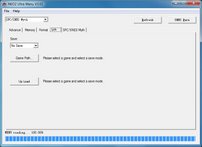
The Link tab allows you to select a game save mode, game path, and upload the save mode to the Neo SNES Myth. This is another tab that is not really necessary to change anything in, so I will move on.
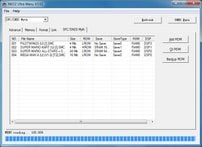
Finally we are at the good part. The final tab is SFC/SNES Myth and is where ROMs are added, cleared, and backed up from the NeoSNES Myth cart. Simply click on Add Rom, select the ROM or ROMs(yes, it does batch adding), and click on Open to add them to the list. Whatever file name the ROMs have is what will be displayed on the SNES/SFC screen when the device is booted up. Clr ROM will completely clear the list of ROMs but will not delete them from the device until the SNES Burn option is selected. Backup ROM will copy the entire contents of the Neo2Flash RAM Cartridge that is inserted in the Neo SNES Myth to the PC, querying for a folder and file name for the ROM image. Refresh will load the list of games stored on the Neo2 and SNES Burn will copy whatever games or changes are made to the list to the Neo2 and Neo SNES Myth cartridge's menu areas respectively.
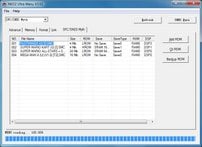
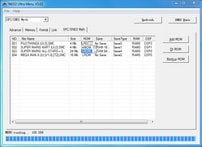
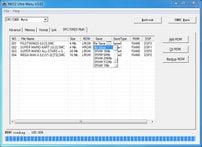
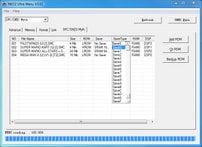
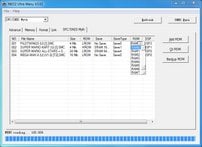
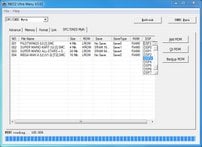
Later on, we will find that a few ROMs need some options changed. Above are photos showing that you can change thegame file name, ROM mode HiROM or LoROM, save size, save type, RAM mode, and add-on DSP chip setting.
Usage - General
Now to show how the device runs. Fully assembled, the Neo SNES Myth should have the Neo2 Flash RAM Cartridge plugged in to the top open slot between the mini B USB port and the ON/OFF switch, SNES cartridge plugged into the back of the device, and plug the Neo SNES Myth directly into the cartridge slot of the SNES system. After this, assuming that there are ROMs on the Neo2, the SNES is ready to be powered on.
After powering on the console, the Neo SNES Myth menu system is very basic and none of the controller button layout is displayed on the screen. This is where reviews and documentation come into play. While it does not show these functions to the user, it is easy to figure out by trial and error. The B button will load the current ROM displayed, the Y button will launch whatever game is on the cartridge plugged in the back of the unit, Start will launch the Neo SNES Myth's internal checking routines, and the up and down arrows will scroll through the file list of games loaded on the Neo2 Flash RAM Cartridge. The rest of the buttons are not assigned and will not do anything when pressed. If accidentally launching the inserted cartridge, the B button will take you back to the main game selection screen. If the Neo SNES Myth Cart self test is executed, the only way out is to power down the console and turn it back on.
The default menu system is of a nice font colored hot pink, teal, and white on a vibrant blue background, displaying Copyright 2010 Neo Team on the bottom of the screen. Although simple, the menu system does not display very much information. To view what games are on the Neo2, it is easier to load it upon the PC in the Neo2 Ultra Menu. When booted up in the console,each file name is displayed individually when pressing the up and down arrows on the directional pad to select between them. It does not ever show the list of all of the files at one time. It just shows each individually in one line.
Usage - Super Nintendo Games & Homebrew
I tested various ROMs and noticed no visual clarity issues. Once a game is loaded, it does not suffer from radio wave interferance aside from what the console's own cables may show. The picture is clean and crisp on a standard CRT television set. Games run fine and have no issues with saving.
Games that are hard coded to be region locked do still behave in that manner. The Neo2 Ultra Menu does not have any fixes builtin to convert PAL to NTSC or vice versa. This is being discussed as a plug-in to be added to the program later on. Currently, theonly ways to change region protections are to either apply an IPS fix for the game that was made by an experienced programmer or use a tool such as Ucon, Ucon64, or SNESTool to convert and deprotect the games. Realistically, it is simple to just get the appropriate region game for the SNES and matching region lockout chip cartridge or pre-cracked ROM image and play that one instead.
Also games that were copy protected in the past are no longer are an issue. Any game that had copy protection not related to region locking will run as long as it is a clean dump. Cracked ROMs will not necessarily boot up on the Neo SNES Myth Cart and can black screen while region cracked/fixed ROMs and clean dumps will work fine.
The Neo SNES Myth Cart comes with 256Mbit of flash RAM on a Neo2Flash RAM Cart which can be filled with up to and no more than that amount of game images. External from that but built into the Neo SNES Myth cart itself is 64Mbit of RAM for loading data. The largest commercial SNES game without a special chip, which actually was a Super Famicom game in Japan, was 48Mbit in size so this should not pose as a problem and the homebrew community appears to abide by these non-set-in-stone rules. Also the translated versions of this ROM do run fine, as they do not exceed the original 48Mbit size but also still are under 64Mbit.
Usage - Super Nintendo Cartridges and Expansions
As long as the cartridge or expansion device is plugged into the back of the Neo SNES Myth cart, it can boot by pressing the B button on the game pad. This is not compatible with plugging it into devices such as the Game Genie and anything plugged into the back, besides a DSP1 game, will not interface with the ROMs on the Neo2 Flash RAM Cartridge currently. Again, these things may change in the future with updates to the internal programming of the cartridge FCPGA or menu software but currently this is how this sample works.
I mentioned earlier that it has special chip support under features. While this is true, currently only the DSP1 and lockout chips can be passed through to ROMs onboard. Any other chips, such as Capcom C4, Super FX, Super FX2, DSP2, DSP3, DPS4,OBC-1, Seta DSP, SA-1, and SDD-1 will not appear to be seen by the Neo SNES Myth cart. This does not mean that it can not see it at all, but right now it can not use those chips at all. All DSP1 and normal LoROM and HiROM games function perfectly.
Neo SNES Myth GUI (Menu)
When you turn on the SNES, a simple menu comes up right away.
The first ROM on the list that was programmed into the Neo2Flash Cart will be displayed.
Pressing the down button on the D-Pad will scroll down to the next ROM on the list. Here is shown after pressing the down arrow twice. Notice that it shows it as game 003 and also has cut off the characters as the file name went over the maximum limit for the menu system.
Internal RAM Test - The start button is used to test the internal RAM and finishes at 64Mbit. Photos above are near finishing the test and at test finish. If all is OK, it will display OK as the status.
BOOT Expansion Slot - The Y button will launch whatever cartridge is inserted in the back of the Neo SNES Myth Cart. Press B to go back to the main menu.
Pressing B again proceeds to launch the inserted cartridge automatically with no load time.
At the main menu, press Y twice to load the ROM shown on the screen. Here is ROM 001 (Pilotwings) in action running from Super Mario Kart (DSP-1).
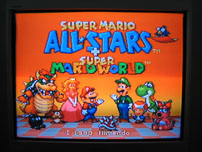
This is a screen shot from Super Mario Bros. 2 USA running from Super Mario All-Stars + Super Mario World (NTSC/U) ROM. Also screen shots from Super Mario Kart.
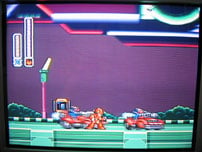
Trained games also work. This is Mega Man X +4 Trainer intro screen, title screen, and in-game.
Performance
Of the games I tested, all ROM only, ROM with save, and ROM with DSP1 worked near flawlessly. The only issues I came across were: Pilotwings (PAL) caused as light graphics glitch when diving on the first level of the game, but it did not cause it to freeze and the game ran like normal beyond that and Prehistorik Man (PAL) came up with the region lockout screen which was alleviated by using the NTSC/U version or the ROM with the region lockout crack and trainer.
The problems I encountered were very minimal. Trainers cannot be turned off in most games that have them. All trainer options are always locked to on even if the intro says they are off or if the trainer's disable buttons are pressed during gameplay. Also games that were under 4Mbit needed to be padded to that size in order to work and games that were other various odd sizes needed to be padded to the nextmultiple of 4Mbit.
ROM Compatibility
PASS:
Game plays just as it should on a real game card.
FAIL:
Game doesn't even load or freezes before game play.
PROBLEMS:
Game works but with issues.
The ROM only and ROM with SRAM games I tested worked flawlessley and are:
- Archer MacLean's Dropzone (PAL) - PASS
- Axelay (NTSC/U) - PASS
- Battle Cross (NTSC/J) - PASS
- Brutal Paws of Fury (NTSC/U) - PASS
- Choplifter III (NTSC/U) (304545) - PASS
- Choplifter III (PAL) - PASS
- Chrono Trigger (NTSC/U) - PASS
- Chuck Rock (PAL) - PASS
- Dino City (PAL) - PASS
- Donkey Kong Country (NTSC/U) (V1.0) (Clean dump) - PASS
- Donkey Kong Country (PAL) (V1.0) (Clean dump) - FAIL on NTSC SNES Region protection screen comes up. Easily solved by using the NTSC/U version instead. Region fix in ucon64 caused black screen only
- Donkey Kong Country (PAL) (V1.0) (Clean dump) -PASS on PAL SNES
- Donkey Kong Country 2 (NTSC/U) (V1.1) (Clean dump) - PASS
- Donkey Kong Country 2 (NTSC/U) (+1 Trainer) - PASS trainer can be enabled or disabled but not turned offin-game
- Donkey Kong Country 2 (NTSC/U) (+4 Trainer) - FAIL Black screen. This is a bad ROM and is a variant of the +1 trainer working above. I have proven this by setting it to HiROM and viewing that the trainer intro is the same.
- Donkey Kong Country 3 (NTSC/U) (Clean dump) -
PASS - Dragon Ball Z - La Legende Saien (French) - PASS
- Dragon Ball Z - Ultimate Menace (French) - PASS
- Earthworm Jim 2 (PAL) - PASS
- F-Zero (PAL) - PASS
- Final Fight 2 (PAL) - PASS
- Frogger (NTSC/U) - PASS
- Front Mission - Gun Hazard (NTSC/J) (English Translated AGTP V1.01) - PASS
- Goof Troop (PAL) - PASS after changing ROM to HiROM
- Gunforce - Battle Fire Engulfed Terror Island (NTSC/U) -PASS
- Kidou Butouden G-Gundam (NTSC/J) (English Translated AGTP V1.00) - PASS
- Killer Instinct (NTSC/U) (V1.0) (Clean dump) - PASS
- Legend of Zelda - A Link to the Past (NTSC/U) - PASS
- The Lion King (NTSC/U) - PASS
- Mega Man X (NTSC/U) - PASS
- Mega Man X (NTSC/U) (+2 Trainer) - PASS trainer is alwayson
- Mortal Kombat II (NTSC/U) (V1.0) - PASS
- Mr. Do! (NTSC/U) - PASS after padding to 4Mbit
- Mr. Do! (NTSC/U) (+1 Trainer) - PASS trainer is always on and was already padded to 4Mbit
- Ms. Pac-Man (NTSC/U) - PASS after padding to 4Mbit
- Prehistorik Man (NTSC/U) (+1 Trainer) - PASS trainer is always on. This game is actually PAL with a region fix and trainer so I am unsure why it is listed in GoodSNES as a US version. So this bypassed the region protection but the trainer caused the game to not function as original due to the trainer being always on. It's actually a +3 trainer but there is only on/off in game so that is probably why it is called +1
- Prehistorik Man (PAL) - FAIL on NTSC SNES Region protection screen comes up. Easily solved by using the +1 Trainer ROM instead, but trainer can not be turned off
- Prehistorik Man (PAL) - PASS on PAL SNES
- Road Runner's Death Valley Ralley (NTSC/U) - PASS
- Rockman & Forte (NTSC/J) (English Translated RMF AGTP V1.00) - PASS
- Seifoku Densetsu - Pretty Fighter (NTSC/J) - PASS
- Street Fighter II Turbo (NTSC/U) - PASS
- Super Street Fighter II (NTSC/U) (Included with thesample) - PASS
- Super Bomberman 3 (PAL) - PASS
- Super Mario All-Stars + Super Mario World (NTSC/U) - PASS
- Super Mario All-Stars + Super Mario World (PAL) - FAIL on NTSC SNES Region protection screen comes up. Easily solved by using the NTSC/U version instead. Region fix in ucon64 caused black screen only
- Super Mario All-Stars + Super Mario World (PAL) -PASS on PAL SNES
- Tales of Phantasia (NTSC/J) (English Translated Lowercase DeJap V1.2) (48Mbit) - PASS
- Tin Star (NTSC/U) - PASS
- Uniracers (NTSC/U) - PASS
- Wild Guns (NTSC/U) - PASS
None of the above games required a cracked version to run and only a few PAL needed a proper region fix. All ROMs function properly with the exception of a bad dump and a few requiring their respective region lockout chip or simply replacing the ROM with one for the lockout chips in use.
All Bandai Sufami Turbo games worked as long as using the ROM with the ST Bios already applied/hacked in as well as most needing to use the overdumped pre-padded version of theROM. The games that were odd Mbit sizes required padding orelse they would mearely black screen before or after the Sufami Turbo boot up screen. After padding though, they just showed instructions on how to load games in the original Bandai Sufami Turbo device so I just used the proper overdump variants of the ROMs found in GoodSNES and everything worked perfectly fine. The overdumps contained the ST Bios and were 12Mbit each. Running the ROM alone without any bios applied or padding will result in a black screen of course since the games originally required additional hardware.
Bandai Sufami Turbo
I own a complete set of NTSC/U retail special chip cartridges so I plugged each one in and tested the result. All special chip games besides Pilotwings and Super Mario Kart, both which are two different variants of DSP1 technology. Those did not allow any software to be run on them unless just using their built in NTSC lock out chips. Super Mario Kart will run all DSP-1 games, but Pilotwings will not play any DSP-1 ROM images.
To be clear you can, for example, take Dirt Trax FX or Mega Man X3 and boot up a copy of a ROM only game such as Super Mario World from them. What you can't do is boot up aROM of Dirt Trax FX or any other Super FX chip game on a Dirt Trax FX cartridge or boot up a ROM of Mega Man X2 or Mega Man X3 off of a Mega Man X3 cartridge. Also you can run any DSP1 game from Super Mario Kart, even Pilotwings without a crack or variant version.
Team Neo's Neo2 Ultra Menu software is calling Pilotwings DSP-3 and only a different DSP-1 cartridge will play its ROM. Also the alternate version of the ROM which was hacked to allow it to work on floppy disk based copiers will only yield a black screen, so a clean dump is required. The Europe version of the game tested on a NTSC SNES system showed some slight graphic glitch on the sky diving stage of the first mission.NTSC and NTSC/J unaltered Pilotwings ROMs worked fine.
Here is the list of special chip cartridges I tested and theresults:
C4
DSP-1
Each DSP1 game works fine. NTSC/J/U/E games tested allworking on NTSC console with the exception of the Pilotwings hack/alternate dump that works on floppy disk based copiers with a HiROM DSP1 cartridge or DSP1 addon chip. Also I noticed some strange graphics glitch on the airport graphics when sky diving on the first mission of Pilotwings (PAL) but not in the NTSC and NTSC/J versions while running on an NTSC console.
DSP-2
Dungeon Master - FAIL Shows the menus, some intro graphics and "Dungeon Master" mode7 effect then shows a square and arrow graphics glitch and halts
DSP-3
SD Gundam GX - FAIL Black screen tested with Super Mario Kart DSP1 inserted
DSP-4
Top Gear 3000 (USA) / Planets Champ TG 3000 (Japan) - FAIL Allows you to go through the menus but when a race is started, the screen turns orange and graphics are corrupt and flashing. Tested with original NTSC/U Top Gear 3000 cartridge inserted
OBC-1
Metal Combat - FAIL Displays all graphics properly but no sprites. Tested with Super Mario Kart DSP1 and then with original Metal Combat NTSC/U cartridge inserted
SA-1
None of these games work. I only have the USA games listed but the Japan cartridges would have the same result. All games except for PGA European Tour and PGA Tour 96 immediately black screen when loaded up. These two games show the EA logo then allow you to go through the menus and start a golf tournament, but once the golf course is started the screen turns black and the game freezes.
All of the NTSC/U games were tested with their own corresponding original cartridge plugged in. These games are: Kirby Super Star, Kirby's Dream Land 3, PGA European Tour, PGA Tour 96, Power Rangers Zeo - Battle Racers, and Super Mario RPG.
S-DD1
Seta DSP
Seta 10 / ST010
Seta 11 / ST011
Seta RISC
Seta 18 / ST018
SPC 7110
As you can see from the above, the only games that fail are bad dumps and games that use special chips other than DSP-1. Calculating these results versus the entire library of ROMs gives us a whopping 99% ROM compatibility of the complete set.
Homebrew Support
I found that homebrew ROMs needed to be set to LoROM and padded to at least 4Mbit if they are not already at that size. These worked flawlessly with these settings, but the trainers could not be turned off in the NES Hack games.
- Anthrox - 3d Demo PASS
- Anthrox - Christmas Demo PASS
- Galaga (NES Hack) PASS
- Lode Runner (NES Hack) PASS
- Magical Demo PASS
- Mappy (NES Hack) PASS
- Mario Bros. (NES Hack) PASS
- Napalm - Laughing Skull Intro PASS
- Nuts & Milk (NES Hack) PASS
It is amazing that every homebrew ROM thrown at this device passes with some only requiring minor tweaks. I expected to run into more problems since most of these were developed for older backup units. This furthers the ROM compatibility and keeps it in line with the near 100% ROM compatibility as stated in the previous section. Also no homebrew ROM requires special chips from retail cartridges, so there is no issue there. Of course it is to be expected that some backup unit BIOS images will not work still since some of them are not in a format that any SNES backup device or emulator can run.
Don't get confused about what you see in this section. I tested the NES Hack ROMs that are included in GoodSNES to see if anything that obscure would work. This cartridge will not run standard NES games and the programming is not capable of converting NES to SNES format. These ROMs were already converted and programmed to run from old backup units a long time ago.
Additional Features
The Neo SNES Myth cart has an expansion slot on the back as mentioned earlier and a standard cartridge male interface on the bottom. Plugging various expansions into the back works fine, but plugging in an extra expansion such as a Game Genie to the bottom interface which normally plugs directly into the SNES console will cause a black screen.
I have tested the following:
- Game Genie - FAIL plugged into the bottom of the cartridge yields a black screen
- Game Genie - PASS plugged into the rear expansion port with a game and loading through the menu works fine. ROM images stored within the Neo2 Flash Cart will not be sent to the Game Genie of course
- Super Game Boy (NTSC/U) - PASS plugged into the rear expansion port and will run Game Boy cartridges or whatever Game Boy flash cartridge is plugged into the Super Game Boy
- Kirby Super Star (NTSC/U) - PASS plugged into the rear expansion port. The game functions normally and is fully playable
- Super Mario World (NTSC/J) - PASS plugged into the rear expansion port. The game functions normally and is fully playable
Super Game Boy running a simple MGD3 16Mbit cartridge and then loading Tetris DX, its gameplay, and showing Super Game Boy features.
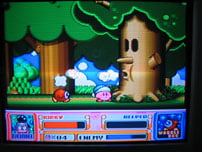
More screen shots of the expansion slot in action. Kirby Super Star is an unsupported ROM, but the original game cartridge works fine when plugged in the back of the Neo SNES Myth Cart.
Conclusion
After having several years of experience with SNES backup devices and seeing what has been released in recent years, this is a pretty high quality product. Sure there are features that should be added and they may still be working on some, but this device is solid and delivers enjoyable cartridge emulation. This device has far less internals than a standard SNES copier from the mid 1990s so it should live a bit better. Not having a floppy drive and having to rummage through and swap diskettes is a good thing. In modern days, we want USB 2.0 rather than parallel port and this device delivers. The USB driver works great in all current Windows operating systems and there is no problem with transferring of ROM images to the Neo2 Flash RAM Cartridge.
This is a good device for someone who wants a very simple GUI, but is not as pretty and feature filled as that of a Super Wildcard DX, DX2, Pro Fighter X, or Smart Bros. The Super Wildcard DX BIOS was 2Mbit and the Neo2 Flash Cartridge has this much space dedicated for its menu as well. This could mean that more features can be added to the menu in the future.
The Neo SNES Myth's internal hardware has some advanced features. The FCPGA on the Neo SNES Myth Cart has 60,000 logic gates which could possibly be used in the future to allow more special chip games to run. Updating the internal firmware on the device can be done as well, but will also require use of a separate USB programming tool that does not ship with the Neo SNES Myth Cart.
With the issues of padding a few ROMs and most trainers being locked to on in trained games seeming fairly trivial and easily corrected, the bad part is this device does not allow an immense amount of storage capacity. The largest Neo2 Flash RAM Cartridge available is 1024Mbit which is 128 megabytes of storage capacity. Team Neo does use good quality Intel Strataflash SMD packaged microchips in the Neo2 Flash Cartridge though and are also working on getting their Neo2 SD Cartridge to work with the Neo SNES Myth. That would allow a maximum of 32 Gigabytes (a whopping 262,144 Megabits) if it supports SDHC and possibly drag and drop support of ROMs.
To conclude, with this as being the final product from Team Neo for SNES, I'd say it delivered most of its promises and is a fine product. With the special chip games accounted for, it supports 99% of all SNES ROM images that are properly dumped and homebrew with the smaller and odd sized ROMs properly padded. It is a good device if you are seeking a small unit that has replaceable flash RAM and USB 2.0 support, as parallel ports are slowly disappearing from modern PC motherboards. It is also nice that it conveniently stores multiple games up to whatever size of Neo2 Flash Cartridge is inserted and properly accommodates their saves. The only major let down of the feature set was offering DSP1 as the only special chip it supports for games. It is also interesting to see a unit that does not support Goldfinger or Game Genie natively and will not respond if one is attached through where the ROM interfaces with the console, but no cheat support was initially promised. Plus the final thing that I found annoying was that most trained games do not function as they should and would work fine on an older backup unit.
I would like to thank Team Neoflash and IC2005 for providing the sample for review.
Pros
+ Easily fits in any SNES/SFC console without any modification
+ Multi lockout chip compatible
+ Simple user interface and intuitive to use on the console
+ Programmable Actel A3P125 FCPGA microchip logic core
+ 64Mbit of RAM which is more than the largest commercial game
+ DSP1 ROMs are fully supported
+ Easy to change ROM modes between LoROM and HiROM in the Neo2 Ultra Menu
+ Supports all ROM-only games of the region corresponding to the console
+ Supports all different SRAM methods for saved games
+ Supports homebrew ROMs
+ USB 2.0 is relatively quick and easily reprogrammed
+ No floppy disks to swap in and out and worry about getting scratched or corrupt
+ Supports booting of cartridge plugged in the back slot
+ Supports multiple ROMs up to the capacity of the flash RAM
+ Clean, crisp display when playing games and no noise/interference
+ Removable flash RAM cartridge for more storage and replacement
+ Larger 1024Mbit Neo2 Flash Cartridge available
+ ROMs are stored indefinitely until flash RAM is erased or overwritten
+ Continued menu, firmware, GUI, and hardware development support
+ Neo2 SD for SD memory card support and Action Replay support are currently work in progress to be added later
+ High quality printed circuit board and onboard components
+ Low solid state part count compared to old floppy based copiers
+ Does not use external power supply or require batteries
+ Does not require external power while flashing ROMs. Can be alone and not plugged into a console
Cons
- No mass storage device support such as SD, TF, CF (SD support is still being worked on)
- No drag and drop support directly to flash memory (SD will have this)
- SNES console user interface has no on screen instructions
- Not compatible with most special chip games
- No external cheat device support
- No built in cheat code program (Action Replay is being worked on to be added to Neo2 Ultra Menu software)
- No real time save
- No built in region fix (Just use the appropriate region ROM or region fixed ROM)
- Most trained games always have all trainer options on and cannot be turned off
- Some ROMs need to be padded in order to work (ROMs less than 4Mbit in size and a few oddly sized larger ones)
- Some ROMs' ROM mode is not detected properly and needs to be manually set
- Takes a while to flash games and loading is not instantaneous
- Plastic black and not grey like SNES cartridges and deck
- Updating the core programming requires a separate USB adapter which is not included
- Supplied 256Mbit cartridge will only hold a small number of games
- Takes a half hour minutes to program the Neo2 Myth Flash RAM Cart to full capacity
- Games do not load instantaneously
External Links:
-Official Team Neoflash Website
-Official Neoflash Worldwide Distributor
Where to buy?:
-IC2005 SmartShop
This review was written for Flashcart Review Central ONLY. The article and all included photos are property of Flashcart Review Central
If you see this review on any other site please let me know via reply to this blog.
Spot on with this article, I really think this website needs more attention. I'll probably be back to read more, thanks for the info.
ReplyDeleteSuper Mario RPG Rom
Thanks. I am thinking about moving all the reviews to Maxconsole. See my latest reviews there.
ReplyDelete